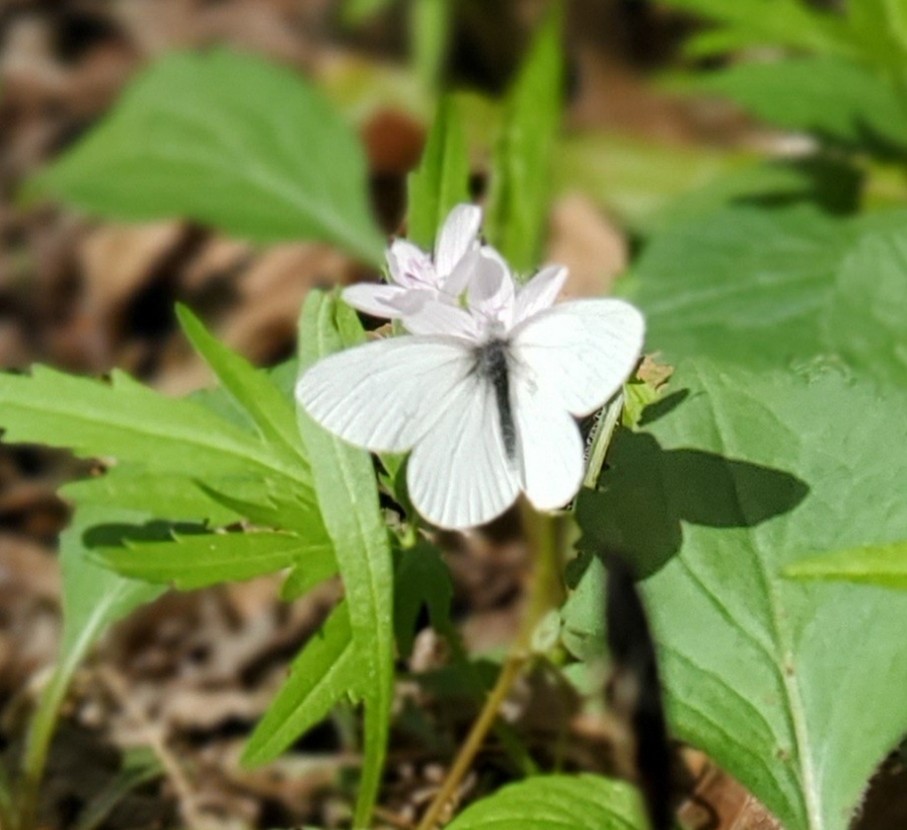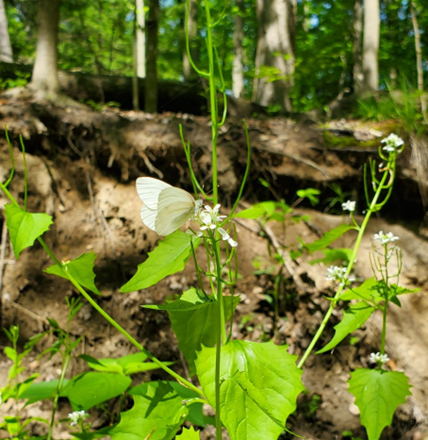Tiered Mentoring
with The University of Akron Department of Biology
On the trail of a rare spring-flying butterfly (Pieris virginiensis)
Stephanie Wilhelm, graduate student in the Miller lab

How do native spring ecosystems respond to species invasion?
Did you know that you can find native Ohio wildflowers blooming in near-freezing conditions? These plants, called “spring ephemerals,” emerge as early as the middle of February and are only out until mid-May. Spring ephemeral plants support wide varieties of spring-emerging insects at a critical time of year when resources (such as pollen and nectar) are limited. These plants are also hosts for the larval stages of many insects, including butterflies like the rare West Virginia white (Pieris virginiensis). I study the response of native spring ephemerals of the genus Cardamine and their insect partners to noxious, invasive plants like garlic mustard (Alliaria petiolata). Garlic mustard, being non-native, highly competitive, and allelopathic, has imposed novel stressors on native Cardamine-insect systems.
In my research, I ask:
- How does the presence of invasive garlic mustard affect pollination success in the native mustards?
- How does the presence of invasive garlic mustard affect the behavior and survival of the West Virginia white butterfly (Pieris virginiensis)?
I am looking to recruit 1-2 students that are willing to work outdoors and have an interest in entomology and botany, in addition to assisting with lab-based projects.
What you’ll learn:
We are looking for approximately 10 hours/week of commitment from you on this project to have the biggest possible impact. During your first semester working with us, you will complete the following:
- Field techniques for native and invasive plant identification
- Insect identification, including field identification and specimen-based identification in the lab
- Field ecology sampling techniques, such as:
- Nectar sampling using microcapillary tubes
- Sampling for volatile organic compounds in plant tissues
- Phenological monitoring (i.e. tracking the growth stages of plants across the season)
- Butterfly monitoring using either transects or point count methods
- Surveying for butterfly eggs and/or larvae
- Lab-based analyses:
- Preparation of floral and insect specimens for viewing under light microscopes and environmental scanning electron microscopes
- Operating light microscopes to obtain magnified pictures of pollen samples
- Digital measurement of magnified pictures using ImageJ software
- Project management

Time commitment:
- Fall semester:
- Weekly lab meetings Mondays at 4pm (Fall 2025, time TBD for Spring 2026) should be attended (except in cases of class/extracurricular conflicts)
- Most lab-based projects (microscopy, sample processing, bookkeeping, etc.) will take place in the fall and winter, with very rare trips to field sites.
- Spring semester:
- Because the plants and insects we are studying are active only in the spring, this will be a very busy time for this project. In the spring, I dedicate nearly all of my working hours to fieldwork (at least 5 days a week). This includes data collection and insect monitoring, among other activities. These can be long days, usually 9am – 5pm. Your classes and coursework come first, but outside of that I would encourage you to join me as often as possible.
